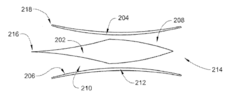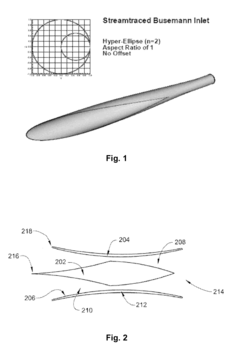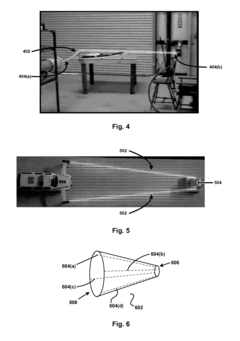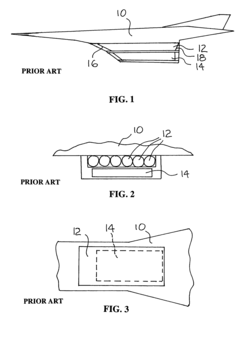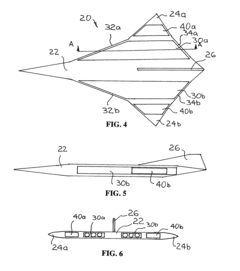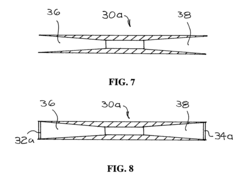Scramjet Engines' Role in Coastal Security and Patrol Operations
AUG 13, 20259 MIN READ
Generate Your Research Report Instantly with AI Agent
Patsnap Eureka helps you evaluate technical feasibility & market potential.
Scramjet Tech Evolution
Scramjet technology has undergone significant evolution since its inception in the 1950s. Initially conceived as a theoretical concept, scramjet engines have progressed through various stages of development, each marked by crucial breakthroughs and innovations. The early years focused on fundamental research and proof-of-concept experiments, with notable advancements in hypersonic flow understanding and materials science.
The 1960s and 1970s saw increased interest in scramjet technology for military applications, particularly in the realm of hypersonic missiles. This period was characterized by extensive wind tunnel testing and the development of computational fluid dynamics models to simulate scramjet performance. However, practical demonstrations remained elusive due to technological limitations.
A major milestone was achieved in the 1990s with the successful ground testing of scramjet engines, paving the way for flight experiments. The early 2000s marked a turning point with the first successful scramjet-powered flight tests, including NASA's X-43A program, which achieved speeds of Mach 9.6 in 2004. This breakthrough demonstrated the viability of scramjet propulsion in real-world conditions.
In the following decade, focus shifted towards improving scramjet efficiency, reliability, and operational range. Advancements in materials technology, such as high-temperature ceramics and carbon-carbon composites, enabled longer engine operation times and improved thermal management. Concurrently, progress in fuel injection and mixing techniques enhanced combustion efficiency and engine performance.
Recent years have seen a renewed interest in scramjet technology for both military and civilian applications. The development of dual-mode scramjet engines, capable of operating efficiently across a wide range of speeds, has expanded the potential use cases. In the context of coastal security and patrol operations, scramjet engines offer the promise of rapid response capabilities and extended patrol ranges.
The evolution of scramjet technology has also been marked by international competition and collaboration. Countries such as the United States, Russia, China, and India have invested heavily in scramjet research, leading to diverse approaches and accelerated progress. This global effort has contributed to a rich ecosystem of scramjet-related technologies and applications.
Looking forward, the trajectory of scramjet evolution points towards increased integration with other propulsion systems, miniaturization for broader applicability, and the development of more robust and reliable designs suitable for regular operational use. As the technology matures, its potential role in coastal security and patrol operations is likely to expand, offering new capabilities for rapid response, long-range surveillance, and deterrence in maritime environments.
The 1960s and 1970s saw increased interest in scramjet technology for military applications, particularly in the realm of hypersonic missiles. This period was characterized by extensive wind tunnel testing and the development of computational fluid dynamics models to simulate scramjet performance. However, practical demonstrations remained elusive due to technological limitations.
A major milestone was achieved in the 1990s with the successful ground testing of scramjet engines, paving the way for flight experiments. The early 2000s marked a turning point with the first successful scramjet-powered flight tests, including NASA's X-43A program, which achieved speeds of Mach 9.6 in 2004. This breakthrough demonstrated the viability of scramjet propulsion in real-world conditions.
In the following decade, focus shifted towards improving scramjet efficiency, reliability, and operational range. Advancements in materials technology, such as high-temperature ceramics and carbon-carbon composites, enabled longer engine operation times and improved thermal management. Concurrently, progress in fuel injection and mixing techniques enhanced combustion efficiency and engine performance.
Recent years have seen a renewed interest in scramjet technology for both military and civilian applications. The development of dual-mode scramjet engines, capable of operating efficiently across a wide range of speeds, has expanded the potential use cases. In the context of coastal security and patrol operations, scramjet engines offer the promise of rapid response capabilities and extended patrol ranges.
The evolution of scramjet technology has also been marked by international competition and collaboration. Countries such as the United States, Russia, China, and India have invested heavily in scramjet research, leading to diverse approaches and accelerated progress. This global effort has contributed to a rich ecosystem of scramjet-related technologies and applications.
Looking forward, the trajectory of scramjet evolution points towards increased integration with other propulsion systems, miniaturization for broader applicability, and the development of more robust and reliable designs suitable for regular operational use. As the technology matures, its potential role in coastal security and patrol operations is likely to expand, offering new capabilities for rapid response, long-range surveillance, and deterrence in maritime environments.
Coastal Security Needs
Coastal security has become an increasingly critical concern for nations worldwide, driven by a complex array of threats and challenges. The need for effective coastal patrol and surveillance operations has grown exponentially in recent years, as maritime borders face risks from illegal activities, environmental hazards, and potential security breaches. These challenges demand innovative technological solutions that can enhance the capabilities of coastal security forces and improve their ability to monitor, detect, and respond to threats in a timely manner.
One of the primary needs in coastal security is the ability to conduct rapid and extensive patrols over vast stretches of coastline. Traditional patrol methods often struggle to cover large areas efficiently, leaving potential gaps in surveillance. This necessitates the development of high-speed, long-range patrol capabilities that can quickly respond to emerging situations and maintain a consistent presence along the coast.
Another crucial requirement is the capacity for real-time intelligence gathering and data processing. Coastal security operations require up-to-date information on vessel movements, environmental conditions, and potential security risks. This demands advanced sensor technologies and data analysis systems that can process large volumes of information quickly and accurately, enabling security forces to make informed decisions and take appropriate action.
The need for enhanced situational awareness is paramount in coastal security. This involves not only visual surveillance but also the ability to detect and track underwater threats, monitor air traffic, and identify anomalies in maritime patterns. Integrated systems that can provide a comprehensive picture of the coastal environment are essential for effective security operations.
Interoperability and communication between different security assets and agencies are also critical needs in coastal patrol operations. Seamless information sharing and coordination between naval vessels, aircraft, land-based units, and command centers are vital for mounting cohesive and effective responses to security threats.
Furthermore, there is a growing need for sustainable and environmentally friendly patrol solutions. As global focus shifts towards reducing carbon emissions and minimizing environmental impact, coastal security operations must adapt to incorporate more efficient and eco-friendly technologies in their patrol and surveillance activities.
The ability to operate effectively in diverse and challenging environmental conditions is another key requirement. Coastal areas can experience a wide range of weather patterns and sea states, necessitating robust and adaptable patrol platforms that can maintain operational effectiveness in various scenarios.
One of the primary needs in coastal security is the ability to conduct rapid and extensive patrols over vast stretches of coastline. Traditional patrol methods often struggle to cover large areas efficiently, leaving potential gaps in surveillance. This necessitates the development of high-speed, long-range patrol capabilities that can quickly respond to emerging situations and maintain a consistent presence along the coast.
Another crucial requirement is the capacity for real-time intelligence gathering and data processing. Coastal security operations require up-to-date information on vessel movements, environmental conditions, and potential security risks. This demands advanced sensor technologies and data analysis systems that can process large volumes of information quickly and accurately, enabling security forces to make informed decisions and take appropriate action.
The need for enhanced situational awareness is paramount in coastal security. This involves not only visual surveillance but also the ability to detect and track underwater threats, monitor air traffic, and identify anomalies in maritime patterns. Integrated systems that can provide a comprehensive picture of the coastal environment are essential for effective security operations.
Interoperability and communication between different security assets and agencies are also critical needs in coastal patrol operations. Seamless information sharing and coordination between naval vessels, aircraft, land-based units, and command centers are vital for mounting cohesive and effective responses to security threats.
Furthermore, there is a growing need for sustainable and environmentally friendly patrol solutions. As global focus shifts towards reducing carbon emissions and minimizing environmental impact, coastal security operations must adapt to incorporate more efficient and eco-friendly technologies in their patrol and surveillance activities.
The ability to operate effectively in diverse and challenging environmental conditions is another key requirement. Coastal areas can experience a wide range of weather patterns and sea states, necessitating robust and adaptable patrol platforms that can maintain operational effectiveness in various scenarios.
Scramjet Challenges
Despite the promising potential of scramjet engines in coastal security and patrol operations, several significant challenges hinder their widespread adoption and effective implementation. One of the primary obstacles is the complexity of achieving stable combustion at hypersonic speeds. The extremely short residence time of air in the combustion chamber, typically less than a millisecond, makes it difficult to ensure complete fuel mixing and combustion.
Another major challenge is the thermal management of scramjet engines. The intense heat generated during hypersonic flight can cause structural damage to the engine and aircraft components. Developing materials and cooling systems capable of withstanding these extreme temperatures while maintaining structural integrity remains a significant engineering hurdle.
The control and stability of scramjet-powered vehicles present additional complications. At hypersonic speeds, even minor perturbations can lead to significant changes in flight characteristics. Designing control systems that can rapidly adjust to these changes while maintaining stable flight is crucial for operational success in coastal security applications.
Fuel efficiency and range limitations also pose challenges for scramjet engines in patrol operations. The high fuel consumption rates at hypersonic speeds restrict the operational range and endurance of scramjet-powered vehicles, potentially limiting their effectiveness in extended coastal surveillance missions.
Furthermore, the integration of scramjet engines with existing coastal security infrastructure and systems presents logistical and operational challenges. Adapting current launch and recovery systems, as well as command and control networks, to accommodate hypersonic vehicles requires significant modifications and investments.
The environmental impact of scramjet engines is another area of concern. The emissions produced by these engines at hypersonic speeds, particularly nitrogen oxides, could have detrimental effects on the atmosphere. Addressing these environmental concerns while maintaining engine performance is a critical challenge for researchers and engineers.
Lastly, the high cost associated with developing, testing, and deploying scramjet technology remains a significant barrier to its widespread adoption in coastal security applications. The complex nature of scramjet engines and the specialized facilities required for testing and production contribute to the substantial financial investment needed to bring this technology to operational readiness.
Another major challenge is the thermal management of scramjet engines. The intense heat generated during hypersonic flight can cause structural damage to the engine and aircraft components. Developing materials and cooling systems capable of withstanding these extreme temperatures while maintaining structural integrity remains a significant engineering hurdle.
The control and stability of scramjet-powered vehicles present additional complications. At hypersonic speeds, even minor perturbations can lead to significant changes in flight characteristics. Designing control systems that can rapidly adjust to these changes while maintaining stable flight is crucial for operational success in coastal security applications.
Fuel efficiency and range limitations also pose challenges for scramjet engines in patrol operations. The high fuel consumption rates at hypersonic speeds restrict the operational range and endurance of scramjet-powered vehicles, potentially limiting their effectiveness in extended coastal surveillance missions.
Furthermore, the integration of scramjet engines with existing coastal security infrastructure and systems presents logistical and operational challenges. Adapting current launch and recovery systems, as well as command and control networks, to accommodate hypersonic vehicles requires significant modifications and investments.
The environmental impact of scramjet engines is another area of concern. The emissions produced by these engines at hypersonic speeds, particularly nitrogen oxides, could have detrimental effects on the atmosphere. Addressing these environmental concerns while maintaining engine performance is a critical challenge for researchers and engineers.
Lastly, the high cost associated with developing, testing, and deploying scramjet technology remains a significant barrier to its widespread adoption in coastal security applications. The complex nature of scramjet engines and the specialized facilities required for testing and production contribute to the substantial financial investment needed to bring this technology to operational readiness.
Current Scramjet Tech
01 Scramjet engine design and configuration
Scramjet engines are designed for hypersonic flight, utilizing supersonic airflow for combustion. Key design elements include inlet configuration, combustion chamber geometry, and nozzle design to optimize performance at high Mach numbers. Advanced materials and cooling systems are employed to withstand extreme temperatures and pressures encountered during operation.- Scramjet engine design and configuration: Scramjet engines are designed for hypersonic flight, utilizing supersonic airflow for combustion. Key design elements include inlet configuration, combustion chamber geometry, and nozzle design to optimize performance at high Mach numbers. Advanced materials and cooling systems are employed to withstand extreme temperatures and pressures encountered during operation.
- Fuel injection and mixing systems: Efficient fuel injection and mixing are critical for scramjet performance. Various techniques are employed, including staged injection, wall injection, and strut-based systems. Advanced fuel formulations and injection strategies aim to improve combustion efficiency and stability across a wide range of flight conditions.
- Thermal management and cooling systems: Scramjet engines operate at extremely high temperatures, necessitating advanced thermal management solutions. Active cooling systems, regenerative cooling, and heat-resistant materials are utilized to protect engine components and maintain structural integrity during sustained hypersonic flight.
- Integration with airframe and propulsion systems: Scramjet engines are often integrated into the vehicle airframe to optimize aerodynamic performance. This integration involves careful design of the forebody, which acts as part of the engine inlet, and the afterbody, which functions as an extension of the engine nozzle. Combined cycle propulsion systems, incorporating turbine or rocket engines for low-speed operation, are also explored.
- Control systems and flight management: Advanced control systems are essential for managing scramjet engine operation across various flight regimes. These systems regulate fuel flow, adjust inlet geometry, and optimize combustion parameters to maintain stable and efficient propulsion. Flight management algorithms are developed to handle the unique challenges of hypersonic flight, including rapid changes in atmospheric conditions and aerodynamic heating.
02 Fuel injection and mixing systems
Efficient fuel injection and mixing are critical for scramjet performance. Various techniques are employed, including staged injection, wall injection, and strut-based systems. Advanced fuel formulations and injection strategies aim to improve combustion efficiency and stability across a wide range of flight conditions.Expand Specific Solutions03 Thermal management and cooling systems
Scramjet engines operate at extremely high temperatures, necessitating advanced thermal management solutions. Active and passive cooling systems, including regenerative cooling, film cooling, and heat pipes, are utilized to protect engine components and maintain structural integrity during sustained hypersonic flight.Expand Specific Solutions04 Integration with airframe and propulsion systems
Scramjet engines are often integrated with other propulsion systems to enable operation across a wide range of speeds. This includes combined cycle engines that incorporate turbine, ramjet, and scramjet modes. Airframe integration focuses on optimizing inlet compression and nozzle expansion to maximize overall vehicle performance.Expand Specific Solutions05 Control systems and flight management
Advanced control systems are essential for managing scramjet engine operation during hypersonic flight. This includes adaptive control algorithms, sensor systems for monitoring engine performance, and integrated flight management systems to optimize trajectory and engine parameters throughout the mission profile.Expand Specific Solutions
Key Scramjet Players
The development of scramjet engines for coastal security and patrol operations is in its early stages, with significant potential for growth. The market size is expanding as nations invest in advanced maritime defense technologies. While the technology is not yet fully mature, several key players are driving innovation. Companies like Northrop Grumman, Aerojet Rocketdyne, and General Electric are at the forefront, leveraging their aerospace expertise. Research institutions such as the Naval Research Laboratory and universities like Harbin Institute of Technology are also contributing to advancements. The competitive landscape is characterized by a mix of established defense contractors and emerging specialized firms, with collaboration between industry and academia playing a crucial role in technological progress.
Aerojet Rocketdyne, Inc.
Technical Solution: Aerojet Rocketdyne has developed advanced scramjet engine technology for coastal security and patrol operations. Their scramjet engines utilize a dual-mode ramjet/scramjet (DMRJ) design, capable of operating efficiently across a wide range of speeds from Mach 3 to Mach 6+[1]. The company's scramjet engines incorporate innovative fuel injection and mixing techniques to achieve sustained hypersonic combustion. For coastal patrol applications, Aerojet Rocketdyne has focused on developing compact, lightweight scramjet designs that can be integrated into unmanned aerial vehicles (UAVs) for long-range, high-speed reconnaissance missions[2]. Their scramjet technology also features adaptive control systems to optimize performance across varying flight conditions encountered in coastal environments.
Strengths: Extensive experience in hypersonic propulsion, advanced materials expertise, and proven track record in defense applications. Weaknesses: High development costs and complexity of integrating scramjet technology into existing coastal security platforms.
Northrop Grumman Systems Corp.
Technical Solution: Northrop Grumman has made significant strides in scramjet engine technology for coastal security applications. Their approach focuses on integrating scramjet propulsion into high-speed, long-endurance unmanned aerial systems (UAS) designed for maritime patrol and surveillance. The company's scramjet engines utilize advanced composite materials and thermal management systems to withstand the extreme temperatures encountered during hypersonic flight[3]. Northrop Grumman has also developed innovative fuel cooling techniques to improve overall system efficiency. For coastal patrol operations, their scramjet-powered UAS platforms are designed to provide rapid response capabilities and extended loiter times at high altitudes, enabling persistent surveillance of vast coastal areas[4]. The company has successfully demonstrated scramjet technology in flight tests, achieving sustained hypersonic speeds above Mach 5.
Strengths: Strong systems integration capabilities, extensive experience in UAS development, and robust supply chain for advanced materials. Weaknesses: Challenges in scaling scramjet technology for smaller, more agile platforms suitable for diverse coastal security missions.
Scramjet Innovations
Energy-Deposition Systems, Equipment and Methods for Modifying and Controlling Shock Waves and Supersonic Flow
PatentActiveUS20150292532A1
Innovation
- The system employs conductive paths along surfaces with energy sources and sensors to assess and control energy discharge, allowing for the modification of shockwaves and fluid flows by depositing energy to start or restart inlets, mitigate blast effects, and manage heat transfer in wind tunnels.
SCRAMjet arrangement for hypersonic aircraft
PatentActiveUS7828243B2
Innovation
- A lateral or side-by-side arrangement of turbojet and SCRAMjet engines, where the turbojet engines' inlet and outlet openings are covered to provide compression and expansion ramps for the SCRAMjet engines, reducing the need for a thick body and minimizing drag.
Maritime Regulations
Maritime regulations play a crucial role in governing the use of scramjet engines for coastal security and patrol operations. These regulations are designed to ensure the safe and responsible deployment of advanced propulsion technologies in sensitive maritime environments. The International Maritime Organization (IMO) has established guidelines for the integration of scramjet-powered vessels into existing maritime traffic systems, emphasizing the need for enhanced communication protocols and collision avoidance measures.
Coastal nations have implemented specific regulations to address the unique challenges posed by scramjet-powered patrol vessels. These include strict noise pollution controls to minimize disruption to marine ecosystems and limitations on operational speeds within certain proximity to shorelines. Additionally, regulations mandate the use of advanced radar and sensor systems to detect and avoid potential conflicts with civilian maritime traffic.
The use of scramjet engines in coastal security operations is subject to international agreements on territorial waters and exclusive economic zones. Regulations stipulate that scramjet-powered vessels must adhere to established maritime boundaries and respect the sovereignty of neighboring nations. This includes restrictions on the use of high-speed capabilities within disputed waters or areas of geopolitical sensitivity.
Environmental considerations are a key component of maritime regulations pertaining to scramjet engines. Strict emissions standards have been implemented to mitigate the potential impact of high-temperature exhaust on marine environments. Operators are required to utilize specialized fuel mixtures and combustion technologies to minimize harmful pollutants and thermal effects on surrounding waters.
Safety protocols for scramjet-powered vessels are particularly stringent, given the high speeds and advanced technologies involved. Regulations mandate comprehensive crew training programs, regular maintenance schedules, and the implementation of fail-safe systems to prevent accidents or malfunctions during coastal patrol operations. Emergency response procedures are also codified, outlining specific actions to be taken in the event of engine failure or other critical incidents.
The regulatory framework also addresses the potential dual-use nature of scramjet technology. Guidelines have been established to prevent the unauthorized transfer or adaptation of scramjet engines for military purposes beyond their intended coastal security applications. This includes export controls and licensing requirements for manufacturers and operators of scramjet-powered patrol vessels.
Coastal nations have implemented specific regulations to address the unique challenges posed by scramjet-powered patrol vessels. These include strict noise pollution controls to minimize disruption to marine ecosystems and limitations on operational speeds within certain proximity to shorelines. Additionally, regulations mandate the use of advanced radar and sensor systems to detect and avoid potential conflicts with civilian maritime traffic.
The use of scramjet engines in coastal security operations is subject to international agreements on territorial waters and exclusive economic zones. Regulations stipulate that scramjet-powered vessels must adhere to established maritime boundaries and respect the sovereignty of neighboring nations. This includes restrictions on the use of high-speed capabilities within disputed waters or areas of geopolitical sensitivity.
Environmental considerations are a key component of maritime regulations pertaining to scramjet engines. Strict emissions standards have been implemented to mitigate the potential impact of high-temperature exhaust on marine environments. Operators are required to utilize specialized fuel mixtures and combustion technologies to minimize harmful pollutants and thermal effects on surrounding waters.
Safety protocols for scramjet-powered vessels are particularly stringent, given the high speeds and advanced technologies involved. Regulations mandate comprehensive crew training programs, regular maintenance schedules, and the implementation of fail-safe systems to prevent accidents or malfunctions during coastal patrol operations. Emergency response procedures are also codified, outlining specific actions to be taken in the event of engine failure or other critical incidents.
The regulatory framework also addresses the potential dual-use nature of scramjet technology. Guidelines have been established to prevent the unauthorized transfer or adaptation of scramjet engines for military purposes beyond their intended coastal security applications. This includes export controls and licensing requirements for manufacturers and operators of scramjet-powered patrol vessels.
Environmental Impact
The environmental impact of scramjet engines in coastal security and patrol operations is a critical consideration that requires thorough analysis. These advanced propulsion systems, while offering significant advantages in terms of speed and efficiency, also present unique environmental challenges.
Scramjet engines operate at hypersonic speeds, typically above Mach 5, which can lead to increased noise pollution in coastal areas. The intense sonic booms produced by these engines may have adverse effects on marine life, potentially disrupting migration patterns and communication among various species. Furthermore, the high-frequency vibrations generated during operation could impact the behavior and well-being of coastal ecosystems.
The combustion process in scramjet engines relies on high-temperature airflow, which can result in elevated levels of nitrogen oxides (NOx) emissions. These pollutants contribute to the formation of smog and acid rain, potentially affecting air quality in coastal regions. Additionally, the extreme heat generated by scramjet engines may cause localized thermal pollution in water bodies, altering the temperature balance of marine environments.
Fuel consumption is another environmental concern associated with scramjet engines. While these engines are designed for high efficiency at hypersonic speeds, they still require significant amounts of fuel for operation. The increased fuel usage in coastal patrol operations could lead to a larger carbon footprint and contribute to greenhouse gas emissions, impacting global climate change efforts.
The materials used in scramjet engine construction and maintenance may also pose environmental risks. Advanced alloys and composites required for withstanding extreme temperatures and pressures could potentially leach harmful substances into coastal ecosystems if not properly managed throughout the engine's lifecycle.
However, it is important to note that scramjet technology also offers potential environmental benefits. The increased speed and efficiency of coastal patrol operations enabled by scramjet engines could lead to reduced overall fuel consumption compared to conventional propulsion systems. This efficiency gain may result in lower long-term environmental impact when considering the entire operational lifecycle of coastal security vessels.
To mitigate the environmental concerns associated with scramjet engines in coastal operations, ongoing research and development efforts are focusing on noise reduction technologies, cleaner combustion processes, and more environmentally friendly materials. Additionally, careful planning of patrol routes and operational protocols can help minimize the impact on sensitive coastal ecosystems.
Scramjet engines operate at hypersonic speeds, typically above Mach 5, which can lead to increased noise pollution in coastal areas. The intense sonic booms produced by these engines may have adverse effects on marine life, potentially disrupting migration patterns and communication among various species. Furthermore, the high-frequency vibrations generated during operation could impact the behavior and well-being of coastal ecosystems.
The combustion process in scramjet engines relies on high-temperature airflow, which can result in elevated levels of nitrogen oxides (NOx) emissions. These pollutants contribute to the formation of smog and acid rain, potentially affecting air quality in coastal regions. Additionally, the extreme heat generated by scramjet engines may cause localized thermal pollution in water bodies, altering the temperature balance of marine environments.
Fuel consumption is another environmental concern associated with scramjet engines. While these engines are designed for high efficiency at hypersonic speeds, they still require significant amounts of fuel for operation. The increased fuel usage in coastal patrol operations could lead to a larger carbon footprint and contribute to greenhouse gas emissions, impacting global climate change efforts.
The materials used in scramjet engine construction and maintenance may also pose environmental risks. Advanced alloys and composites required for withstanding extreme temperatures and pressures could potentially leach harmful substances into coastal ecosystems if not properly managed throughout the engine's lifecycle.
However, it is important to note that scramjet technology also offers potential environmental benefits. The increased speed and efficiency of coastal patrol operations enabled by scramjet engines could lead to reduced overall fuel consumption compared to conventional propulsion systems. This efficiency gain may result in lower long-term environmental impact when considering the entire operational lifecycle of coastal security vessels.
To mitigate the environmental concerns associated with scramjet engines in coastal operations, ongoing research and development efforts are focusing on noise reduction technologies, cleaner combustion processes, and more environmentally friendly materials. Additionally, careful planning of patrol routes and operational protocols can help minimize the impact on sensitive coastal ecosystems.
Unlock deeper insights with Patsnap Eureka Quick Research — get a full tech report to explore trends and direct your research. Try now!
Generate Your Research Report Instantly with AI Agent
Supercharge your innovation with Patsnap Eureka AI Agent Platform!
